Queen Elizabeth I visited the port in 1561 spending the night in a palatial house situated where numbers 19/20/21 Church Street currently stand.
Christopher Jones was probably born in Harwich about 1570, local church records show he was married twice in the local parish church. His father (also Christopher) died in 1578 leaving his house at 21 King’s Head Street and his share in the Mary Fortune to his son. It is likely that this is when Christopher Jones purchased a share in Mayflower. He moved to Rotherhithe in 1611 where he was contracted to take the PIlgrim Fathers to the new World. They set sail from Rotherhithe in July 1620 then on to Southampton, Dartmouth and finally leaving England from Plymouth. High Court of Admiralty records on 26th May 1624 state the vessel was in a ruinous condition and had value of £128.4.0d. Captain Jones died in March 1622 and is buried in St Mary’s church Rotherhithe. Timbers from the hulk were used to construct a barn on a farm near to Dartmouth, in 1930 the barn still remained.
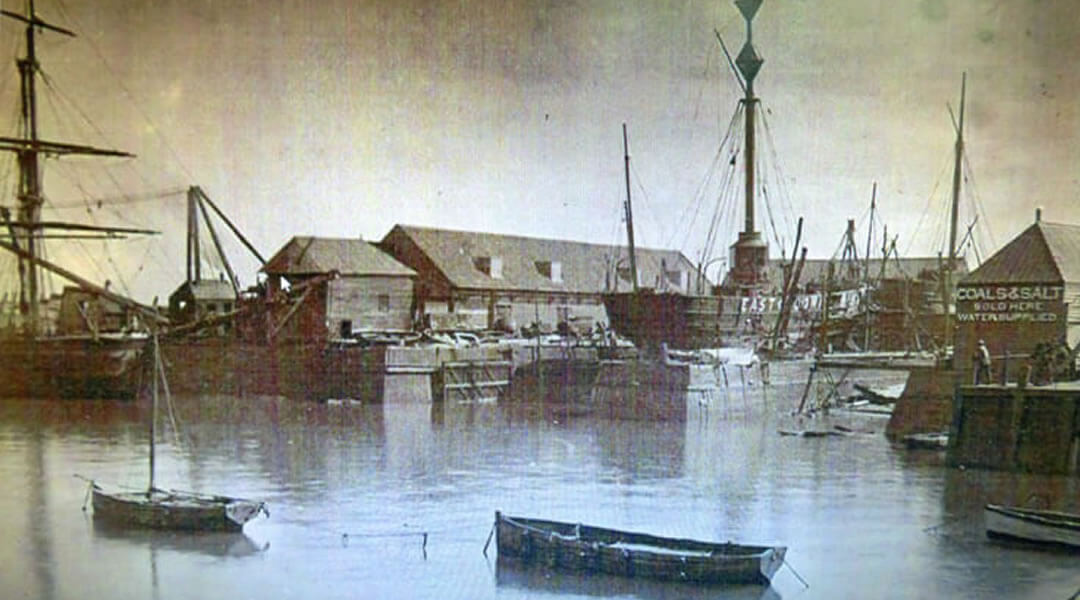
In 1657 it was decided to set up a ship repair base at Harwich but with the countries finances being in a poor state following the period as a republic so it was closed in 1660 by King Charles. The king has second thoughts and a shipyard was constructed and opened in 1664 with its first ship being launched in February 1666, Rupert was a sixth rate battle ship carrying 66 guns. Known as the King’s Yard it past to private hand in 1742 under the ownership of John Barnard. In January 1784 the house leased by the current yard’s owner, Joseph Graham, at the corner of King’s Quay Street and Outerpart East caught fire with the family asleep inside. The all escaped but despite the quick action of the townsfolk the house was destroyed, the two naval vessels under construction, Castor and Excellent were safe. That Joseph Graham leased land close to his old property and had built a new palatial home known today as Naval House. The site of his original house then became an enclosed public market and the site for public floggings. With new shops opening the market went into decline and was closed about 1900 but not demolished until shortly after the Second World War. The shipyard by now known as the Royal Naval Shipyard went into decline finally going bankrupt in July 1927 under the ownership of William Blenkinsp McClearon having made losses for the previous five years.
Until 1673 council meetings were held at the Guildhall in St Austin’s Lane when they took over a former public house in Church Street. The property was rebuilt in 1769 into its current appearance.
King William III in 1694 introduced fast new “packet” vessels on the postal service. On four occasions the king had stayed over night in Harwich two of his later nights was at today’s 18 Church Street.
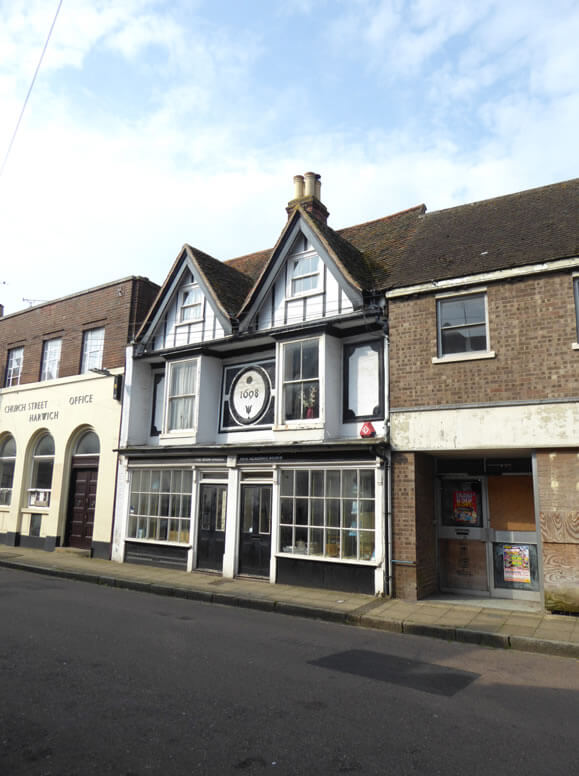
On 6th September 1761 Princess Charlotte arrived at Harwich from Mirow, Germany on board the royal yacht Carloline via Holland on her way to marry King George III. She landed at the shipyard where she was escorted to her carriage by shipyard owner, John Barnard, on route to London. The king should his appreciation and awarded the contract to build the frigate Terrible to the yard. The frigate was launched o 4th September 1762. King George I/II/II all frequently travelled through Harwich on route to Germany, their Hanover link led to the names of Hanover Square, Hanover dining rooms and the Hanover the public house appearing in Harwich. On 16th August 1821 the body of the late Queen Caroline to be returned to Germany on the frigate Glasgow.
On Sunday 9th August 1801 H.M.S. Medusa anchored at the rolling ground in Harwich harbour with Vice Admiral Horatio Nelson on board. The next morning a cutter was landed and sent to the Royal Naval Shipyard to load stores setting sail back to the Thames at 10.00. The Admiral was rumoured to have spent the night at the Three Cups Hotel in Church street though where he slept has since been demolished.
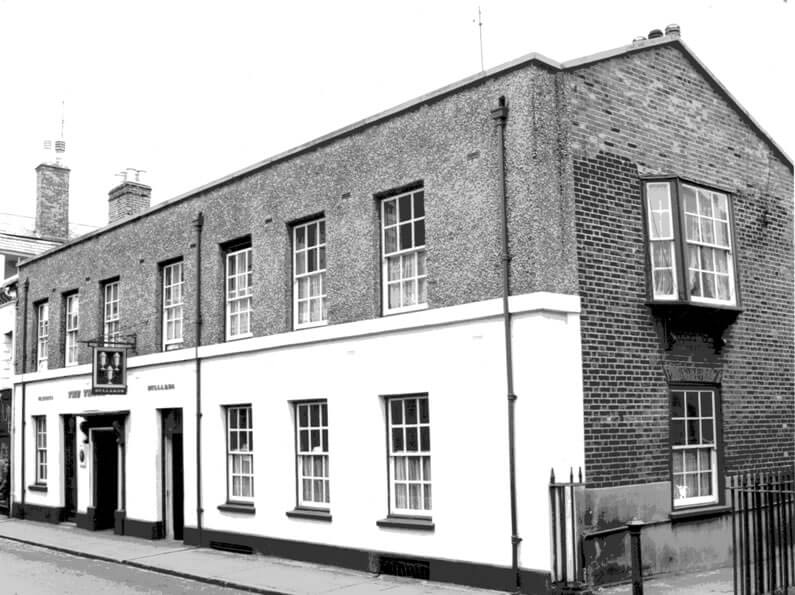
Launched from the yard on 22nd November 1801 was the 1,850 ton frigate Conqueror. She went on to form part of Nelson’s weather division at the Battle of Trafalgar.
On 22nd July 1822 the current St Nicholas church was consecrated replacing an earlier church on the same site. The new building was built in London Brick Coade Stone in the Perpendicular style with a seating capacity for 1,500 parishioners. The church had cost 20,000 to construct with 1,000 being donated by King George IV.
In May 1856 a Naval Review was held at Spithead. The P&O Steamship Company, 516 gross ton ship Iberia built in 1836 made two voyages from Corporation Pier (Halfpenny Pier) to the Review, this vessel was scrapped later that year.
The Eastern Counties Railway Company opened a new railway line between Harwich and Manningtree on 15th August 1854 calling at Dovercourt, Wrabness, Bradfield (from 1856) and Mistley.
The Harwich Corporation was keen to develop Harwich as a port. In preparation for the arrival of the railways the Corporation took out a £9,700 loan from the Provident Life Company to construct a quay wall from the Royal Naval Shipyard to opposite King’s Head Street and to build a pier. The pier would be 243 feet long and 23 feet wide, mid way would be an 213 feet long arm heading east. The Harwich Improvement, Quay & Pier Act was passed in 1851. Messrs E. Smith of Woolwich was awarded the £12,305 contract with the first pile being sunk on 5th June 1852. The Corporation had problems repaying the loan so money was borrowed from the Eastern Counties Railway Company and latterly the Great Eastern Railway Company with the option for them to purchase the development. On 17th September 1852 the Ipswich/London paddle steamer Cardinal Wolsey became the first vessel to berth at the newly completed quay known as Angel Quay being oposite the public house of that name.
Corporation Pier was officially opened on 2nd July 1853, a toll of a halfpenny was charged per adult, a horse and cart 1/6d two horses and cart 4/- animals arriving or departing by steamer were charged 2/- per horse, a head of cattle 1/- a sheep/lamb/pigs 1d and calves 2d. On 13th July 1853 Pearl was chartered by the European Union Railway Benevolent Institute to take a party of over 500 around the harbour to inspect the new facilities.
In January 1853 work commenced on the construction of a new single track 10.5 mile branch line connecting to main line with Harwich at Manningtree.The first locomotive to arrive at Harwich Town arrived on 29th July 1854 the line being officially opened on 17th August 1854 when passengers arrived at Harwich by train from Bishopsgate Station, walked the short distance to Coporation Pier to board the North of Europe Steam Navigation Company’s steamer Aquila and set sail at 11.00 bound for Dunkirk, the start of a history of Continental ferry services from the port. The stations of the newly opened line were Mistley, Wrabness, Dovercourt and finally Harwich, Bradfield station opened in 1856. The Great Eastern Railway Company purchased the pier in 1872 when it became known as Halfpenny Pier reflecting the toll at the time to walk its planks (only those that have not made a serious study of local history refer to this as Ha’penny Pier). The early continental service was not successful but by 2nd May 1855 the Eastern Counties Railway Company chartered Aquila and Cygnus at £40 pounds per week per ship running a twice weekly service between Harwich and Antwerp.
In May 1856 a Naval Review was held at Spithead with P&O’s Iberia making two sailing from the Harwich pier with sightseers. The Great Eastern Railway Company decided to open a service from Harwich with Rotterdam and chartered the newly completed Blenheim at £95 per week making her first sailing from Rotterdam arriving at Corporation Pier on 4th October 1863, from then on the service was fairlt successful.
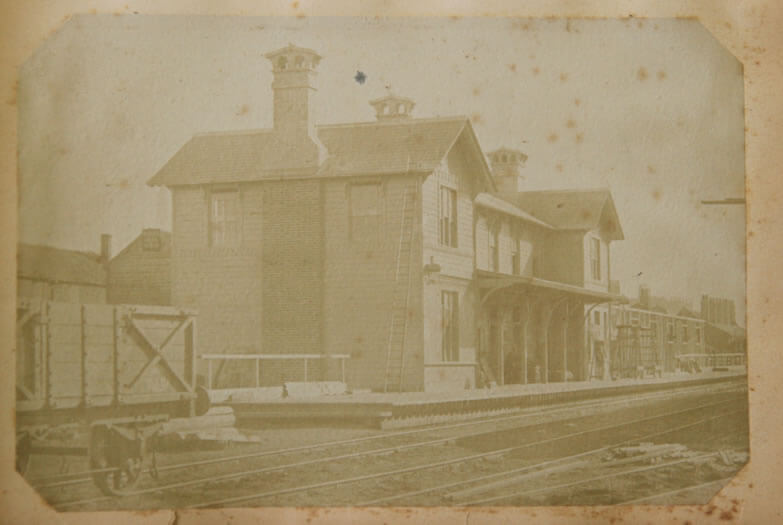
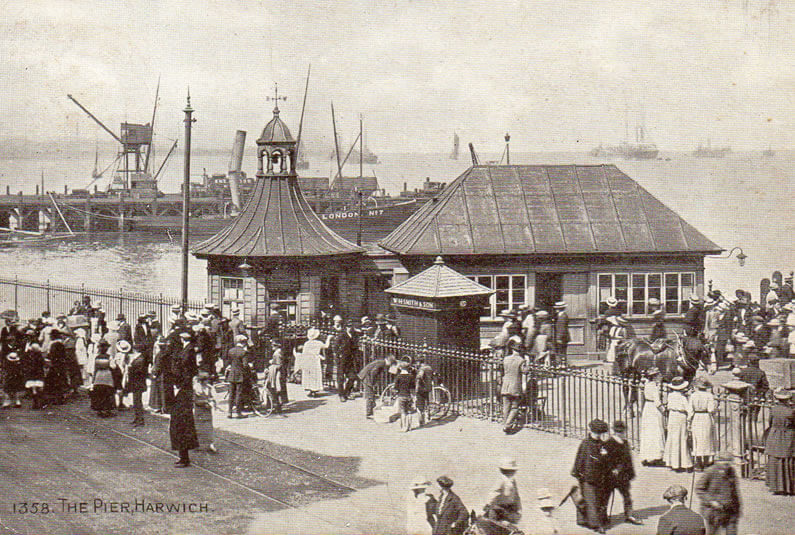
The quay development was soon proved to be too small for the rapid increase in continental traffic. Work started on extending the sea wall westwards then turning into Gashouse Creek, (the gas works was completed in 1854 producing its first town gas in January 1855). The development included extra railway sidings at the end of George Street requiring the demolition of the original station and a new brick one constructed on its site today. A new pier was constructed, to be known as Continental Pier, now the site of Trinity Pier. It was completed in September 1864 but did not go into use until 5th April 1865 due to it deviating from the original drawings. The G.E.R. took on the 60 year lease from the Crown Commissioners for an annual rent of £25. Built by Messrs Perry & Jackson the new pier cost some £6,490 to construct. It was 400 feet long and 90 feet wide, originally cattle pens ran along most of the piers length but by the turn of the century these had been converted into a warehouse which was been divided into two. This warehouse was let to S. R. Groom’s who paid the G.E.R. an annual rent of £45, they used the shore portion to store timber whilst they sub let the seaward end to Herbert Gooding’s of Ipswich, to store grain and animal feed. Trinity House also had berthing rights for their tender Satellite along with an area to store buoys and anchor chains, for this they paid G.E.R. £60 annually. This pier was equipped with railway tracks to convey freight and cattle around the country and had its own steam crane. In October 1871 the G.E.R. purchased Corporation Pier and Harwich Quay from the Corporation for £10,971. Traffic at Parkeston Quay was building up; this was resulting in congestion and delays. The G.E.R. decided to install gaslights on the pier in August 1901 and to commence using the pier again to discharge some of their continental cargo traffic. The Continental Pier continued to be used in this way until the first berth on the new extension at Parkeston Quay was available in August 1907.
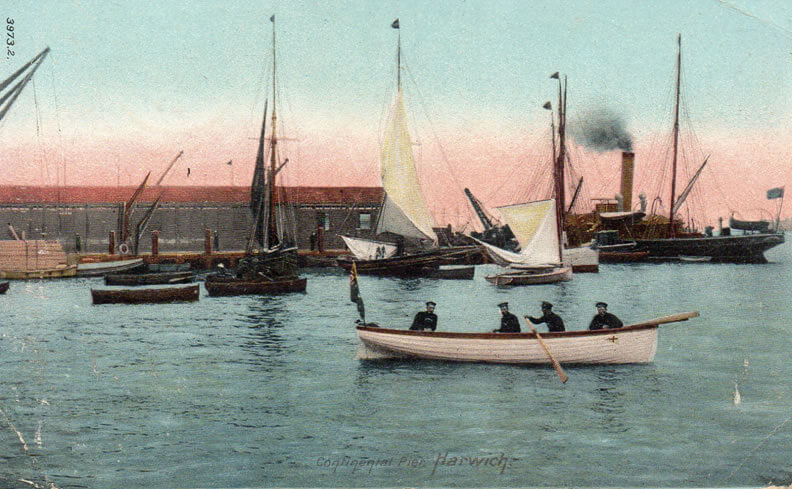
On 12th July 1865 the Great Eastern Railway Company opened their new palatial hotel on the quay front which had cost over £5,000 to build. The site had formerly been occupied by “The Rookery” it had earlier been the Custom House and later a meeting house and still later a store and base for local fishermen. The Italian style building contained 24,000 square feet of floor space, on the exterior between the ground and first floor level royal figures that have had some connection with Harwich were carved in stone. The ground floor boosted a dining room, coffee room, smoking and billiard room, also on the ground floor was a tavern which had its own street entrance at the north west corner of the building. The first floor contained seven large sitting rooms, a private billiard room and two large rooms with partitions that were used for private functions. Four “best” bedrooms and six standard bedrooms were also situated on this floor. The second floor comprised of fourteen bedrooms all of which were fitted with stoves and mantle pieces, a further two sitting rooms were also on this level.
Situated on the third floor were another fifteen bedrooms and a water closet. On the roof was a 70’ x 10’ promenade protected by iron railings. The store rooms were in the cellars and this area, together with all floors, was linked using a hand-operated hoist. Also in the cellars there was an engine driven pump which supplied water, from a well through a sand filter to all the rooms.
Adjacent to the east of the hotel, on a site formally occupied by a restaurant and tearoom the local Masons had a 60 feet frontage and 25 feet deep meeting hall constructed, this was officially opened on 12th May 1896. Following the purchase of the Harwich and Dovercourt Public Hall in 1904 they transferred to their new site. Harwich Borough Council converted this building into public toilets in 1953.
Parkeston Quay was officially opened on 15th February 1883 though the first commercial ships to dock there were on 6th September 1882 when cargo steamer Harwich arrived from Rotterdam followed a few hours later by Pacific from Antwerp.
There was a major drop in hotel trade between 1883 and 1907 due to the opening of Parkeston Quay, the hotel only made a profit in two years, 1886 and 1893. As a result of these heavy loses, the hotel was put up for sale at public auction on 21st February 1907 as a going concern. The bidding reached £8,300, but this was under its reserve price, so the property was withdrawn. The hotel was closed on 27th April 1908 but much opposition from local traders, the council and the general public led to a re think. There was also concern within the ranks of the Great Eastern Railway, the Continental Steamship Committee, who also ran the harbour paddle steamer services, felt this closure was affecting their services and lobbied the Hotel Committee to reconsider. The Continental Steamship Committee was eventually successful; the hotel was refurbished, connected to the Company’s electricity power station at Parkeston and re-opened on 30th March 1912.
At this time railway tracks still ran along the quay roadway, these had been laid when cargo was handled and ships bunkered at the Halfpenny Pier. Whilst work was underway modernising the hotel all but one track was removed and the roadway covered in tar macadam, this work together with the hotel work cost G.E.R. over £12,000.
The G.E.R. opened a tearoom at Easter 1900 on a site between Kings Head Street and Eastgate Street, this site had previously been Robert Hill’s coal yard. A tunnel under Eastgate Street connected the tearoom with the hotel. The idea was to get permission to build this facility then close the loss-making hotel after a discreet period of time. Unfortunately the sale of the hotel did not materialise, so it was the tearoom that closed on 25th July 1907. Although the following year the hotel was closed, like the hotel the resulting public views led the tearoom to be re-opened on 2nd April 1912.
The Harwich Harbour Conservancy Board had been formed in 1863 as the port authority. At the beginning of the century Captain Murray was the Harbour Master. He had served on H.M.S. Enterprise when this vessel went out in search of the Sir John Franklyn Expedition in 1850-1855. Captain Murray retired in 1901. The Harwich Harbour Conservancy Board purchased their first steam launch for £300 in 1907. The Doris, a 33 feet long vessel was purchased second hand having been built for service on the River Tees. This craft served the Board until it was sold for £16 in June 1926. The Board went to Rowhedge Ironworks for their first purpose built launch in June 1925, this £1,265 motor vessel was christened The Lady Packet.
To improve navigation into the port of Harwich two lighthouses, the high and the low were constructed in 1818 at a cost of £8,000. They ceased operation in 1863. The high lighthouse is now a radio museum and the low lighthouse also known as the umbrella lighthouse due to the shelter built at ground level in March 1898 is a maritime museum.
Harwich had become a small Trinity House station in 1817 with Ready making frequent calls. From 1902 became an official station with the 1882 built Satellite stationed here.Today Harwich is Trinty House’s headquarters.
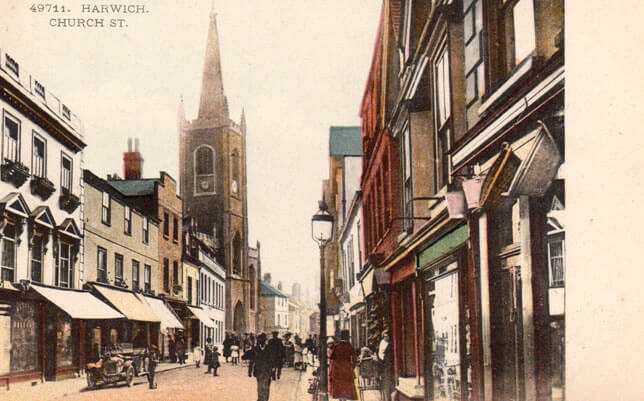
The fishing industry played an important part of the prosperity of the town at the turn of the century with some 47 fishing boats registered at Harwich employing some 110 men.
When the 1901 built cargo steamship Tolesby berthed at the Continental Pier in June 1906 she made history by discharging her record size cargo of 5,325 tons of grain there. (In November 1996 Wasi Swan discharged 21,500 tons of grain at Harwich International Port). A serious fire on 17th June 1910 fire that had started in Gooding’s warehouse on the pier resulted in serious damage. After the fire remains of the warehouse were removed and temporary repairs were undertaken to return the pier to an operational condition. Cargo ships could still be handled as well as cover Trinity House’s requirements. It was under these circumstances that the largest ever timber cargo, 3,026 logs was discharged at Harwich in June 1913, having arrived from Texas. It was the practice at this time to discharges the logs then chain a number together and tow them to a timber pond for storage, near Dovercourt station. The vessel delivering the cargo was the steamer Brooklet, at 3,257 tons gross she had been built in 1911.
The fire had left the Continental Pier in need of serious reconstruction and with heavier cargo traffic it was decided to demolish it completely, repair the quay face and construct a new pier. On 22nd April 1915 the £7,300 contract was awarded to Messrs Jackaman & Sons. The new pier was to be slightly shorter, at 310 feet but slightly wider at 95 feet. The war resulted in delays, work commenced early in 1917, by the end of the year the old pier had been demolished and the quay face repaired. Unfortunately it was at this point that Messrs Jackaman’s entire workforce were ordered on to War Office work, this resulted in suspension of the pier work. It was not until 3rd April 1919 that work started to build the new pier at a new estimate of £11,300. The new pier was officially completed on 7th April 1921, with Trinity House being the main users, there being only small quantities of commercial traffic the pier became known as Trinity Pier. In 1919 the G.E.R. took over their land previously leased to W. Groom. The last surving G.E.R. crane was demolished in August 1951.
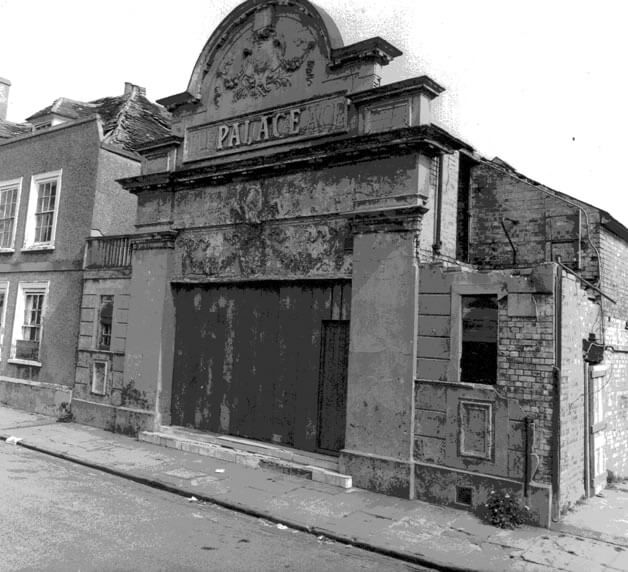
Alderman S. R. Groom officially opened Harwich’s first cinema the Electric Palace on 29th November 1911 showing the silent film “Battle of Trafalgar” followed by “The Death of Nelson”. An inventor of cinematographic equipment, William Friese Greene briefly lived at 5 Cliff Road, Dovercourt before moving back to London until his death aged 65 on 5th May 1921, he is buried at Highgate Cemetery.
On 10th March 1930 now renamed Palace the first sound movie was shown, “The Singing Fool”. Apart from a brief period following the 1953 floods the Palace remained opened until showing its final film “Mad About Men” on 3rd November 1956. Cinema audiences now wanted to stay at home and watch television, the manager locked the doors and that was thought to be the end of the Palace. In April 1975 the Electric Palace Trust was formed to restore and re-open the cinema which they did on 29th November 1981.
With the war over, the military vacated the G.E.R. hotel some £4,000 was spent redecorating it and installing new electrical cooking equipment, in preparation for its re-opening on 21st April 1920. Its life was short lived and lost money heavily, the hotel finally closed its doors for the last time at the end of September 1923.
The Halfpenny Pier had been heavily used by the Royal Navy throughout World War 1 but had received little maintenance. With the war over, for safety reasons the section to the north of the eastern arm was fenced off though anglers regularly climbed over it in pursuit of their sport. In April 1920 the Great Eastern Railway Company allocated £5,500 to rebuild this section of pier, but using concrete piles. At this time negotiations underway whereby the G.E.R. amalgamated with other railway companies to form the L.N.E.R. so the Halfpenny Pier project was put on hold. This work must have been fated for on Friday 13th July 1923 this section of pier was discovered on fire. Paddle steamers services were temporarily transferred to the Trinity Pier whilst repairs were undertaken to replace the fence and repair the section of pier still used by the public when joining either the motor boat services of the paddle steamer services. Early in 1927 new piles pickled in creosote arrived by train from Lowestoft and stowed at the base of Trinity Pier. A few weeks later, on 23rd May, they caught on fire, although no damage was done to the pier, the piles were unusable. The north westerly section of Halfpenny Pier remained in a derelict condition and during gales in May 1943 the centre section collapsed into the sea. The navy decided this area was a danger to their vessels and commenced its demolition in June using the salvage vessel Freija and the launch Jeff to demolish the pier, some 146 pies were removed. The work was completed in the July. At this time the L.N.E.R. mud dredger Landguard, was busy at the train ferry terminal in case it was required to load landing craft in preparation for the invasion of France so it was not for another four months that she became available to dredge the demolished pier site. When this was commenced more old piles were discovered in the sea bed which Landguard was used to remove.
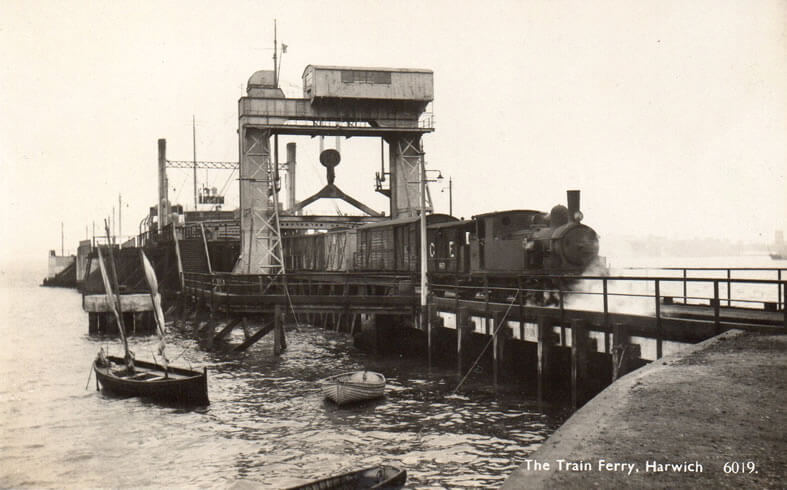
In March 1923 a new company was formed the Great Eastern Train Ferry Company, to operate a train ferry service between Harwich and Zeebrugge. Three ferries were purchased along with initially two and later three World War 1 terminus from Southampton, and Dunkirk. The Dunkirk terminus was successfully relocated to Zeebrugge but the Southampton one sank whilst 2.5 miles off Harwich, the linkspan was recovered but replacement towers and machinery later arrived from Richborough. At 11.00 on 24th April 1924 a special train arrived at Harwich with Prince George (later Duke of Kent) on board to officcially open the new service. After setting the bridge equipment in motion he was given a guided tour of Train Ferry No.2 before she set sail to Zeebrugge. Train Ferry No 3 joined the service the following day sailing daily except Sundays, the third ferry entered service on 17th July 1924. The service was not a financial success and by 1932 was making an annual loss of £3,485, in July 1933 the company was bankrupt. The London & North Eastern Railway Company took over the route and the service began to flourish. With the outbreak of World War 2 the continental port was transferred to Calais until the lock gates there were badly damaged. Two ferries were lost during the war with only Train Ferry No 1 now renamed Essex Ferry to re-open the service on 16th August 1946. New ferries were built Suffolk Ferry in 1947, Norfolk Ferry in 1951, Essex Ferry in 1957 and Cambridge Ferry in 1964. All these ferries had virtually the same rail capacity and were becoming uneconomic so a larger ferry, Speedlink Vanguard was chartered from September 1980 until the service was closed in January 1987 in preparation for the opening of the Channel Tunnel. The train ferry terminal remains now in a deteriorating condition.
In 1935 the L.N.E.R. were still responsible for the maintenance of the Harwich Quay face and roadway between the Angel Steps and the Halfpenny Pier. Negotiations were entered into with Harwich Borough Council would give their now empty hotel to the Council in exchange for the Council taking over responsibility for the upkeep of the quay face and roadway between the Royal Naval Shipyard and Halfpenny Pier. The hotel was considered to be worth between £80,000 and £100,000 when restored. On 27th Feb 1936 the deal was signed together with a purchase agreement for the Quay Pavilion now used by the Harwich Church Institute. Harwich Borough Council purchased the length of roadway between the Royal Naval Shipyard and the Church Street junction from the L.N.E.R. on 7th February 1938. On 7th February 1972 the Harwich Borough Council purchased the remaining section of roadway between George Street and Church Street from the British Railways Board.
Trinity House started to replace their old pier in 1955. A western longitudinal length was demolished and a new pier constructed, using concrete piles. When this work was completed the remaining portion was demolished. The new pier, 32 feet wide, was 63 feet narrower than the old structure. This procedure meant that at least one berth was operational at all times. The quay face between Trinity Pier and Halfpenny Pier was getting into a poor state of repair. In December 1957 work commenced sheet piling this section which at this time was still owned by British Transport Commission.
By the 1930s the Guildhall was considered to be too small for its role as a town hall. The Borough Council looked to purchasing a replacement site, one building considered was Cliff Hall, the building was estimated to be worth £6,000 but the sale failed to materialise. Secondary offices were acquired around Harwich, part of the Lloyds Bank block in Kings Quay Street was used as the Accounts Department, the former Free School Buildings for the Buildings, Surveying and Sanitary Department, the Clinics and Welfare had offices in West Street. The Town Clerk operated from Messrs Hanslip Ward offices in Church Street and Naval House was also used. When in 1936 the council took over the ownership of the former Great Eastern Railway hotel it was decided this would make an ideal town hall. With war looming no further action was taken, but in October 1951, this old hotel officially became Harwich Borough Council’s new town hall.
With the declaration of World War 2 many large buildings were taken over by the Ministry of War for the accommodation of service personnel, both Cann’s and the Royal Naval Shipyard were re-opened and equiped for war service. Fishing boats Molly, E. Thomas, Boy Fred F. Good of West Street, Rememberance F. Good of Waddeston Road, Carmen H. Garnet and Volo T Bennett helped in the Dunkirk evacuation. The Railway steamers became troopships and hospital carriers taking part in the evacuation from Dunkirk and the Normandy Landings with voyages far and wide in between. After the war the buildings returned to their usual use but the Royal Naval shipyard was sold remaining in commercial use until 1962.
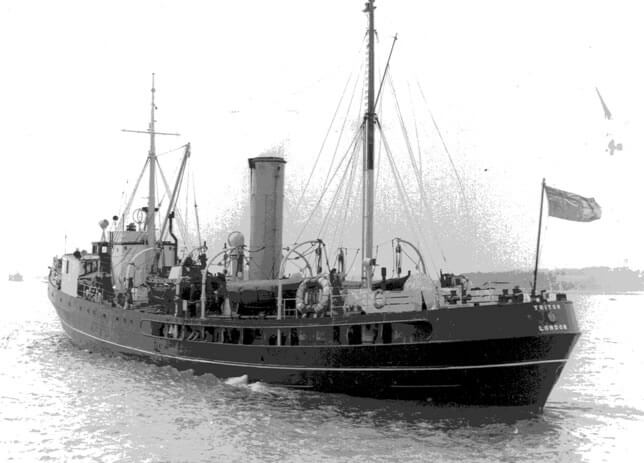
On 14th May 1958 an Aquilla Airways seaplane landed in the harbour on a test flight, the plan was to operate passenger flights between Harwich and Continental ports including Lisbon. In reality Harwich was only used on rare occasions when for some reason the planes could not land at Southampton. The last flight took place in September 1958.
A telephone call one evening, received by the Mayor, Councillor Syd Simmons, informed him that a company was looking for a site at one of the Haven ports to construct a quay where new cars could be handled for the import and export trade. Sid contacted the Harwich Conservancy Board, and the local Member of Parliament, Mr Julian Ridsdale; negotiations were entered into, resulting in the construction of a 750 feet long wharf out from the old shipyard site.
On 3rd January 1964 the £0-5M new quay was officially opened and christened Navyard Wharf. On that same day, the Bore Line vessel, Bore VII berthed discharging a cargo of forest products before loading 100 Vauxhall and Bedford Chassis for her return to Finland, a weekly conventional cargo service had commenced. The following day the first side loading car ship Traviata arrived, (3,046 tons gross).
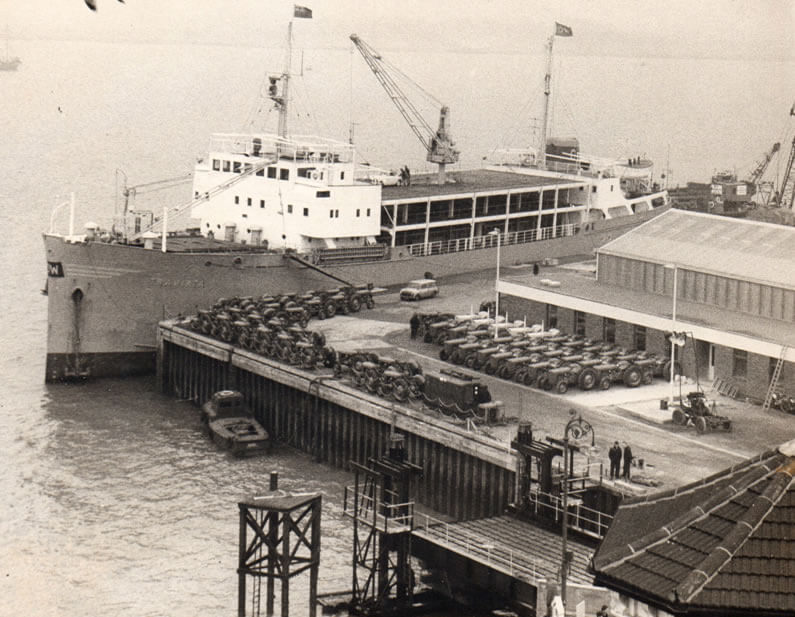
This vessel initiated Navyard Wharf’s biggest customer, Wallenius Lines linking it with Scandinavia and the Baltic ports. On 12th January the first of a series of five bow loading vessels arrived, Aniari, at 499 tons gross this vessel had space for 350 cars. A year later, the first of two slightly larger sisters, Don Juan at 878 gross tons, entered service. Car exports to the United States of America commenced on 2nd June 1965 with the sailing of the 1938 built, 4,840 gross ton Undine to Boston and New York. A few days later the 1961 built, 6,415 gross ton Har Ramon sailed to Philadelphia.
In 1966 Wallenius Lines commenced a thrice-weekly service with Antwerp using their new stern loading ship Undine at 1,961 tons gross. Many changes took place on this route over the years but the most significant came in 1978 when it was taken over by Cobelfret. The stalwarts of the service were the 1979 built sister ships Belvaux and Clervaux though many ships have worked this route.
Prinz Line transferred their Bremerhaven passenger service from Parkeston Quay to Navyard Wharf on 1st January 1969 using the chartered Thoresen vessel Viking III. From March the regular vessel, Prins Hamlet now renamed Prinz Hamlet returned to the Harwich route.
A new purpose built ship Prins Oberon arrived on her maiden voyage in June 1970. At 7,932 gross tons the new ship provided berths for 692 passengers and space for 250 cars or equivalent freight space. In 1978 this vessel was renamed Prinz Oberon. With the arrival of the new ship Prinz Hamlet opened new service to Hamburg. At the end of the 1970 summer season she was replaced by the chartered Norwegian car ferry Vikingfjord which was now renamed Prinz Hamlet II.
In November 1973 a new purpose built ship, Prinz Hamlet entered service. Berths were provided for 572 passengers with space for 225 cars or equivalent freight capacity. Prinz Hamlet II was withdrawn from service and is currently sailing in Greek waters. Due to engine trouble on the new ship Dana Sirena (built in 1969 as Aalborghus) was time chartered for 50 days between March and June 1975.
The reorganization of local government in 1974 led to the formation of Tendring District Council, this now took control of local affairs. Since the Royal Charter of 1604 the Harwich Borough Council had acquired priceless regalia, to keep this in Harwich it was decided to retain a council even though it powers were limited to running the local allotments, thus keeping the memorabilia in the town. The Council made the Guildhall their base resulting in the former G.E.R. hotel being sold for £100,000 in December 1983. The building was sold again four years later for £750,000, within months it was being converted into flats.
The transfer of the German passengers services from Navyard Wharf from 1st May 1982 to Parkeston Quay led to a moral blow to the old town as passengers increased the local businesses trade.
Argo Line opened a new freight service between the Wharf and Germany on 27th March 1984 with the arrival of Antares.
In 1974 the Harwich Harbour Conservancy work boat St Joan was sold and re-named Island Diver. She was replaced by Saint Joan which had been built by Brooke Marine in 1964 as a pilot boat for the Preston pilots. Her change of ownership was recorded as 6th June 1974. Pilot cutter Pathfinder, built in 1955 was sold in June 1986. Changes in legislation meant from 1987 Harbour Conservancy Board became responsible for the pilotage and the navigational aids in their district. Harbour House, Navigation House and the Halfpenny Pier are all now harbour authority property. The following year the Board became known as the Harwich Haven Authority.
On 11th May 1987 the luxury ferry Earl William arrived at the train ferry terminal. This vessel had been chartered by the Home Office as temporary accommodation for asylum seekers to alleviate overcrowding at other centres. There was some opposition to this project, largely from people living outside the town, some part time residents and the regular group of local protesters. Under this vessel’s original name, Viking II, she had in its earlier life been a regular user of the harbour, having opened the Felixstowe/Zeebrugge passenger service in October 1974. The Home Office charter was terminated in November 1987. After a brief period of service in the Irish Sea Earl William was sold for service in the Adriatic Sea and later the Aegean Sea. In 1992 she sank at Chaguaramas whilst under tow.
On 20th August 1986 a new service linking Navyard Wharf with Libya was inaugurated with the berthing of June Lady, a service that continues to this day. The wharf received a set back when Bore Line announced it was amalgamating its services with Finnlines and transferring their traffic to Felixstowe from January 1992. A new company was formed, ArgoMann, and within a few weeks opened a replacement weekly service. The hardest set back for Navyard Wharf came in January 1993 when Cobelfret transferred their UK terminus to Purfleet.
In 2002 a new lifeboat station was opened by Navyard Wharf for the local lifeboat Albert Brown and an Atlantic 75 inshore craft. Also included was a gift shop and training facilities. Although there has been interruptions in service Harwich became a lifeboat station with the arrival of Springwell on 21st January 1876 as a result of the grounding of the German vessel Deutschland on 5th December 1875 on the Kentish Knock.
The start of the new century has seen improved facilities for the yachting fraternity and the restoration of Halfpenny Pier together with new facilities for visitors; Harwich Haven Authority must be congratulated for this. It is a great shame the waterfront has been disfigured by the erection of posts that are not in line and reduce parking places. The festoon lighting dangling from the posts would be more suitable at a market or funfair than along an historic waterfront so after a few years were removed by public demand.
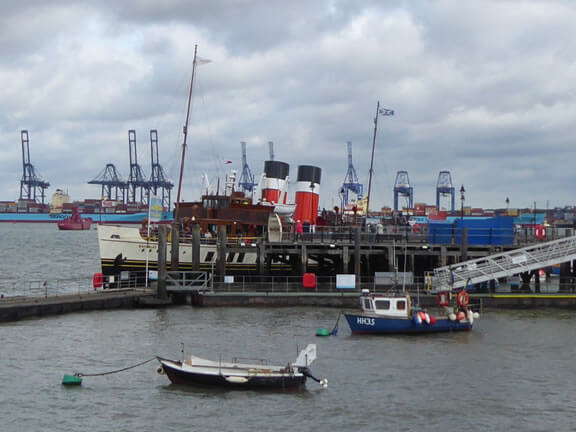
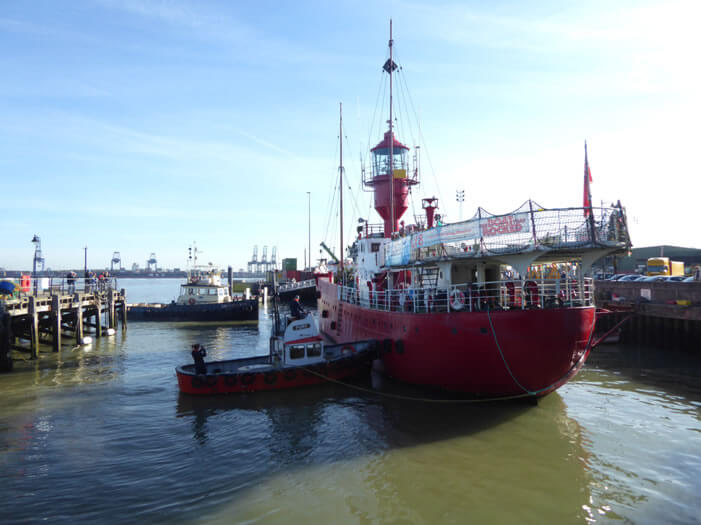
The Pharos Trust was established in 2002 acquiring light ship LV18 currently moored opposite the Pier Hotel and open to the public from 2011. She had been built by Philip & Son at Dartmouth where launched on 2nd April 1958 by Mrs C St Glasson. Three months later she had been completed and towed to the St Gowan station, her latter working life was on the Dowsing station before in 1989 being laid up in Harwich harbour.